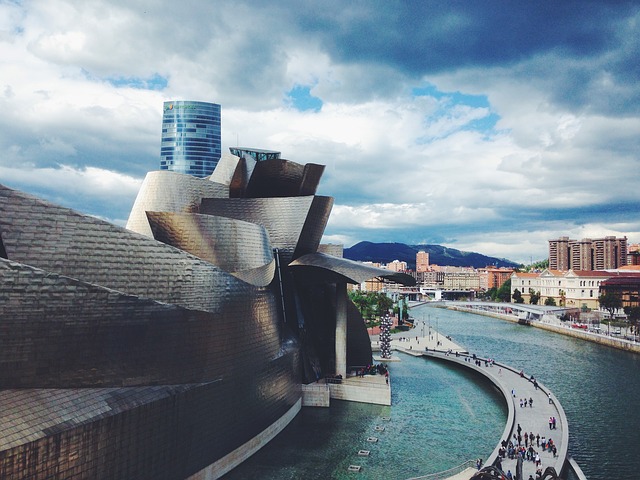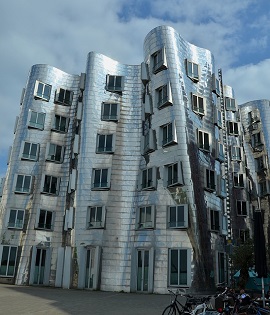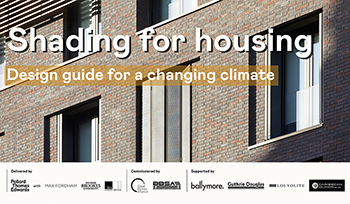Frank Gehry
Frank Gehry is widely regarded as one of the most influential and revered figures in modern architecture. He is known for ‘statement’ buildings that challenge preconceived ideas about aesthetics and form in a way that is as controversial as it is celebrated. Perhaps his most famous building is the Guggenheim Museum in Bilbao, a Deconstructivist masterpiece and one of the defining buildings of the 20th century.
Gehry was born in Toronto, Canada in 1929 and moved to Los Angeles in 1947, the city with which he is most commonly associated. He took an architecture course at Los Angeles City College, initially on a whim, and went on to graduate from the University of Southern California. After an abortive spell at the Harvard Graduate School of Design and a year studying in Paris, Gehry returned to Los Angeles and established Gehry Associates.
While initially working in the European-modernist style of Le Corbusier and the Bauhaus, he was drawn to the avant garde arts scene of Los Angeles’ Venice Beach and Santa Monica, and began to hone his own creative vision. He made a name for himself with a line of furniture called Easy Edges, and began to be commissioned to design buildings such as the Rouse Company headquarters in Columbia, Maryland, and the Santa Monica Place shopping mall.
His breakthrough came in the late-1970s when he renovated his own home, now known as the Gehry Residence, that with its unconventionally expressive use of chain-link fences and corrugated steel was seen as a showpiece for a new Deconstructivist style of domestic building. The attention gained by this work allowed him to incorporate new experimental designs into buildings such as the Cabrillo Marine Aquarium (1981) and the Air and Space exhibit building (1984), as well as buildings in Switzerland and Germany.
By the end of the 1980s, Gehry had established himself as a key figure in international architecture, known for his injection of playful elements into otherwise ‘serious’ designs. His reputation was secured on being awarded the prestigious Pritzker Architecture Prize in 1989.
In the early 1990s he designed the Chiat/Day Building in Los Angeles, with its distinctive binoculars entrance. In 1996 he built the ‘Dancing House’ in Prague with its twisting steel shapes and concrete paneling.
In 1997, he completed the Guggenheim Museum in Bilbao, Spain, with its sweeping titanium contours and irregular curves, that was widely regarded as a masterpiece of modernist architecture. The ‘Bilbao effect’ was a term derived from the socio-economic benefits that the city enjoyed as a result of the museum opening.
In a similar style he went on to design the Walt Disney Concert Hall (2003) in Los Angeles, and the Experience Music Project in Seattle.
He has since become one of the few architects whose critical acclaim and media visibility has branded him the title of ‘starchitect’. He is widely sought by developers for ‘statement projects’ that gain immediate, widespread attention simply because of his involvement.
Most notable buildings:
- Gehry Residence, Santa Monica, California.
- Binoculars Building, Venice, California.
- Dancing House, Prague, Czech Republic.
- Guggenheim Museum, Bilbao, Spain.
- Gehry Tower, Hanover, Germany.
- Experience Music Project, Seattle.
- Walt Disney Concert Hall, Los Angeles.
- 8 Spruce Street, New York.
[edit] Find out more
[edit] Related articles on Designing Buildings Wiki
Featured articles and news
Editor's broadbrush view on forms of electrical heating in context.
The pace of heating change; BSRIA market intelligence
Electric Dreams, Boiler Realities.
New President of ECA announced
Ruth Devine MBE becomes the 112th President of the Electrical Contractors Association.
New CIAT Professional Standards Competency Framework
Supercedes the 2019 Professional Standards Framework from 1 May 2025.
Difficult Sites: Architecture Against the Odds
Free exhibition at the RIBA Architecture Gallery until 31 May.
PPN 021: Payment Spot Checks in Public Sub-Contracts
Published following consultation and influence from ECA.
Designing Buildings reaches 20,000 articles
We take a look back at some of the stranger contributions.
Lessons learned from other industries.
The Buildings of the Malting Industry. Book review.
Conserving places with climate resilience in mind.
Combating burnout.
The 5 elements of seiri, seiton, seiso, seiketsu and shitsuke.
Shading for housing, a design guide
A look back at embedding a new culture of shading.
The Architectural Technology Awards
The AT Awards 2025 are open for entries!
ECA Blueprint for Electrification
The 'mosaic of interconnected challenges' and how to deliver the UK’s Transition to Clean Power.
Grenfell Tower Principal Contractor Award notice
Tower repair and maintenance contractor announced as demolition contractor.
































Comments
Weisman Art Museum in St.Paul, MN & Eisenhower Memorial in Washington d.c. would greatly add to the tribute.